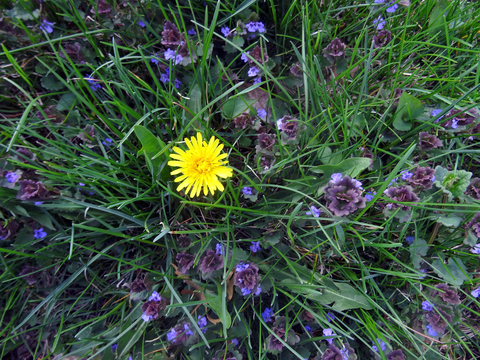Weeds in lawns and gardens
"A weed is a plant out of place." By this definition, any plant could be considered a weed if it is growing in a location where it is not wanted such as plantain in your lawn.
But weeds are more than just a visual intruder.
Weeds can be detrimental to the health of your lawn or garden and should be managed regularly using best cultural practices such as hand removal and mulching. If an infestation occurs, you may resort to using herbicides.
- Weeds compete with desirable plants for space, light, moisture, and nutrients.
- They can be hosts to diseases like aster yellows.
- Weeds can host insects that can carry disease from plant to plant or infect plants by feeding on them.
- They spread vigorously by seed, plant parts, rhizomes or stolons.
- Weeds tolerate a wide range of environmental growing conditions and establish easily in lawns and gardens.
- Some weeds are sometimes a source of allergens.
We do not cover all possible weeds, just the most common and troublesome ones in Minnesota. Some weeds are classified as invasive and should be reported to the appropriate authorities when found.
Common weedy plants
- Birdsfoot trefoil
- Canada thistle
- Crabgrass
- Creeping bellflower
- Dandelions
- Dutch white clover
- Garlic mustard
- Ground ivy (creeping Charlie)
- Plantain
- Quackgrass
- Wild violet (common blue violet)
- Yellow wood sorrel
Weed identification
Find photos and descriptions of plant characteristics that can help you identify common Minnesota weeds.
How some weedy plants benefit wildlife
Some weedy plants may benefit pollinators, birds and other plants, and have medicinal benefits to humans. For example, Dutch white clover is rich in nectar; as it is a legume, it fixes nitrogen and makes it available to other plants nearby. Dandelions are native to Europe and were brought to the United States in the 1600s as an edible and medicinal plant. The flowers have abundant pollen for early-season pollinators.
Invasive vs. noxious weeds
Some plants are considered to be weeds in both managed and natural landscapes. An example is Canada thistle. These plants are listed as noxious weeds by the Minnesota Department of Agriculture and the Minnesota Department of Natural Resources and eradication is strongly recommended.
Some plants are also considered invasive, but not noxious.
- According to the Minnesota Department of Agriculture, "Minnesota noxious weeds are annual, biennial, or perennial plants that the commissioner of agriculture designates as having the potential or are known to be detrimental to human or animal health, the environment, public roads, crops, livestock, or other property. The MDA Noxious Weed Program's goal is to protect Minnesota's citizens, economy, and agricultural and natural resources from the negative impacts of invasive plants and noxious weeds."
- According to the Minnesota Department of Natural Resources, "An invasive plant in Minnesota is a plant that is not native to Minnesota and causes economic or environmental harm or harm to human health."
- It's important to understand that not all non-native species are invasive. According to Minnesota Statute 84D.01, an invasive plant is a non-native species that:
- causes or may cause economic or environmental harm or harm to human health; or
- threatens or may threaten natural resources or the use of natural resources in the state.
If you have questions about managing noxious weeds, visit the Minnesota Department of Agriculture.
For questions about managing invasive species, visit the Minnesota Department of Natural Resources.
Stay up to date
- Read Yard and Garden News
- Listen to the Smart Gardens and What's Killing My Kale? podcasts.


